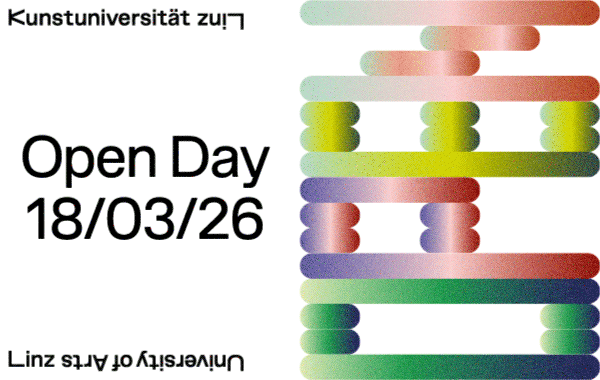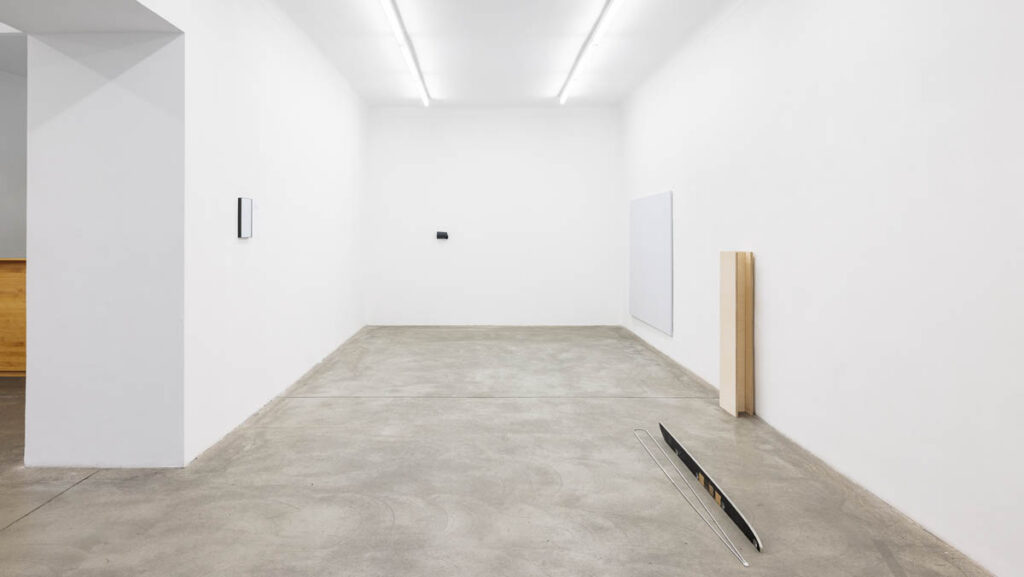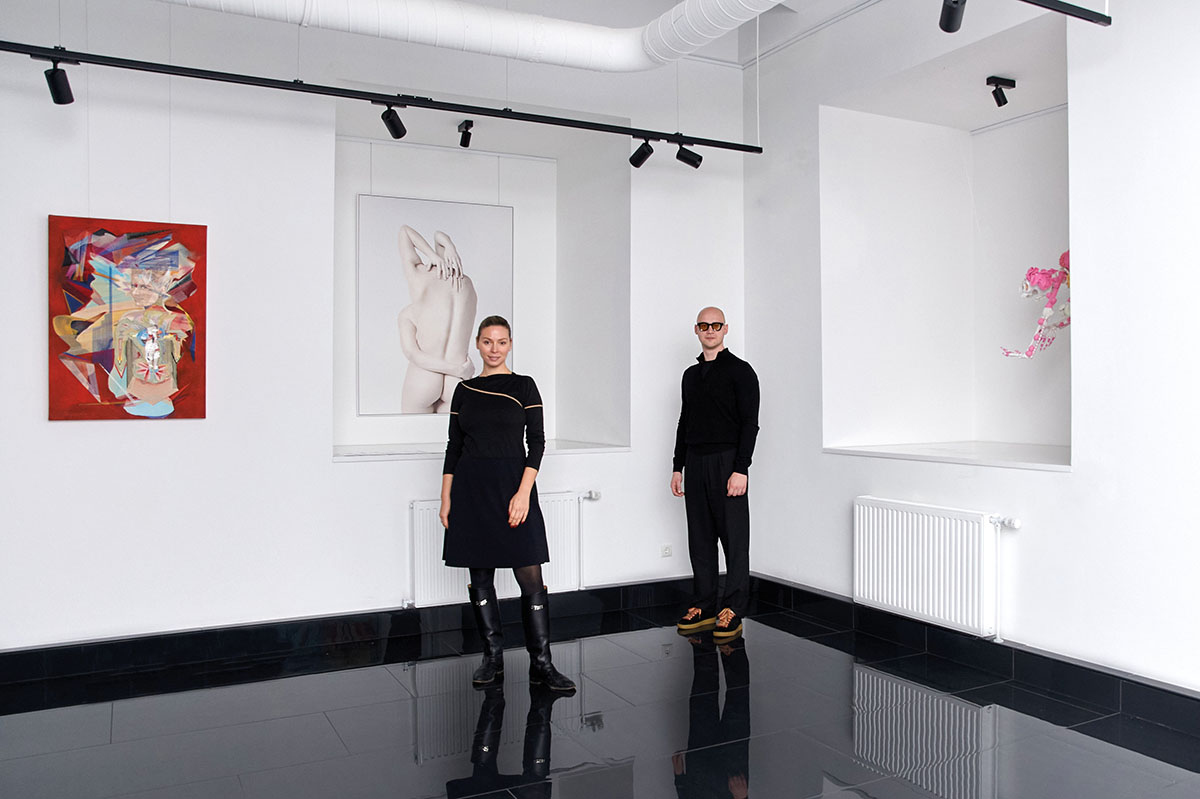
Ruslan, you are the managing director of Salz Vision Gallery. Could you tell me a bit about your background?
Ruslan Stetski: I was born in a small city in Estonia. My family has been in real estate development for generations. I grew up surrounded by that solid mindset about how reputation is the most important thing and how actually to achieve and maintain it. Art has always been a part of my life. When I was younger, I attended music school, and I played piano and liked painting different things. At the same time, I was also very active in sports, like hockey. I always had this multidisciplinary approach to life, combining physical, creative, and intellectual activities.
When did you come to Vienna?
Ruslan: I moved to Vienna right after graduating from high school. As soon as I began my studies at the university, I immediately started my career in real estate and have been working in that field ever since. It was essential for me to study at one of the best universities possible. I chose to attend Vienna University of Economics and Business.
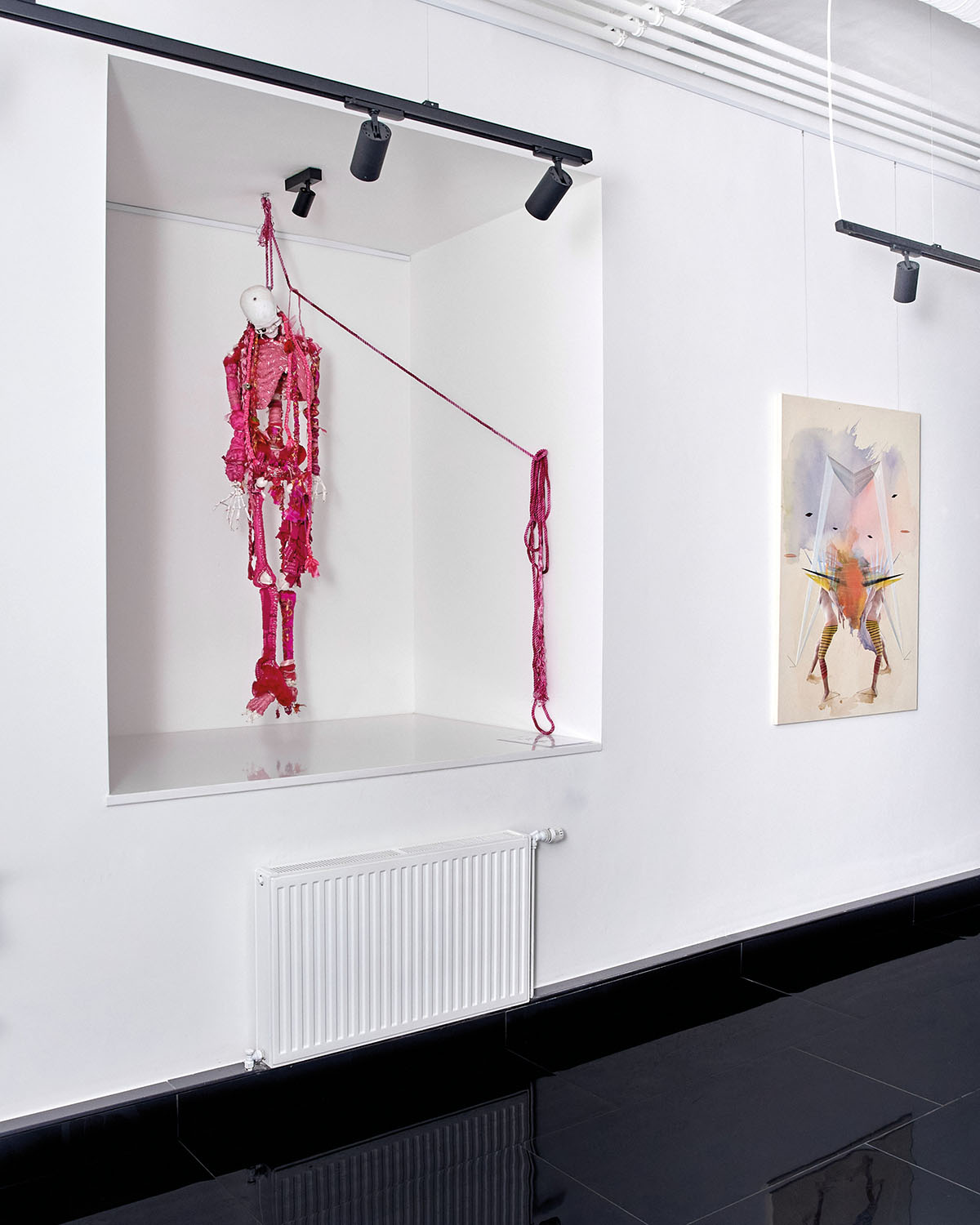
When did your career start to evolve more independently?
Ruslan: In 2022, I started working independently in real estate because the reputation I had gained over the years started working in my favor. Consequently, that got me to a new level in my career. Some time before that, my career had connected me with some wonderful people who later on became my long-term partners and friends. Among them is the family that owns the gallery.
How did the collaboration with the gallery develop, and when exactly did that happen?
Ruslan: That was in 2021. I remember clearly—it was during quarantine, and I was constantly on calls with lawyers and clients who were also the gallery owners, negotiating and finalizing the deal. It was a hectic but exciting time. Real estate transactions can take months; over time, we got to know each other really well. At some point, they even invited me to participate as an artist in their gallery in Budapest. That experience was interesting. But soon after, we all realized that it might make even more sense for me to work with them as the managing director of the new gallery in Vienna.
While I was helping them find the right property for the future gallery, we found a great off-market deal, a beautiful space. I still remember the day we transferred the future gallery to its new owners, as one of them turned to me and said, “Rus, are you willing to work with us?” That was the exact moment my story with the gallery officially began. That’s how the gallery project took off.

You work both in real estate and in art. How do these two worlds connect for you?
Ruslan: In real estate, my main focus is investment consulting, helping clients find and acquire meaningful, sustainable assets. I’m an investor myself, and I understand that for an investor, it is crucial to find a partner who really well understands your needs, either in real estate or in art. For me, these two spheres are very complementary. The audience that invests in art often overlaps with those who invest in real estate. They share a similar mindset—people interested in value, aesthetics, and long-term vision.
Could you tell me a bit more about how you work with your clients in real estate and how that transforms into how you work with clients in the art world?
Ruslan: My clients are usually people looking to purchase something, either residential or commercial, as an investment. I listen to their needs, and I help them find the best possible way to make that investment and make the entire process as convenient and comfortable as possible. What’s really important for me is that my work doesn’t stop when the deal is signed, but it’s exactly the opposite. That’s something unusual in this field, but I believe that once the investment is made, the real work begins: maintaining trust, staying in touch, and making sure everything continues to work well. Ultimately, the client’s satisfaction has always been the most important thing.
And I think that applies both to real estate and to art. In both spheres, reputation and the authenticity of what you do and how you connect with your clients really matter.
Ruslan: Exactly. The results of my work, whether in real estate or art, always come down to the client’s satisfaction. I’m also very selective about who I work with, since, in my opinion, it is a very important factor. I pay close attention to building relationships with clients who truly value collaboration and choose me as a reliable partner. I think that’s crucial. It’s better to have fewer clients who appreciate your work and share your values than many more clients who don’t. Since I started working more independently, shortly after, I have realized that, and my work has become much more effective, enjoyable, and rewarding. That was a catharsis for me. It made me realize that you don’t have to overwork or go crazy. You just have to choose the clients who also choose you as a partner. And I think that the market always has the right partner for every client; it’s only a matter of finding it. Only then can you focus properly and deliver the best possible results.

Anne, you are a curator and author. Could you introduce yourself and your background?
Anne Avramut: I come from a theoretical background in contemporary art, but my roots are in archaeology and philosophy, which I studied. Even though I focus on contemporary questions, I always frame them within a historical context. My work took me across Europe from Saint Petersburg and Moscow to various cities and also to the United States, in New York and Los Angeles.
Many people are not aware that archaeology is actually the quintessential Visual Study. In fact, most art-historical methodologies were developed within archaeology. Methodologically, it doesn’t matter whether an image or object was created 3,000 years ago or three years ago; the questions we ask about images remain the same. Of course, context and time play a role, but the way we approach the visual language is consistent. Everything I know about images I learned from my professor of Greek Archaeology, Marion Mayer, an exceptional woman. And studying philosophy allowed me to ask broader questions about art and knowledge. I enjoy moving between highly theoretical thinking and very hands-on work with art. This creates a very dynamic and flexible space for my curatorial practice.

Since October, you’ve been the curator and director of Salz Vision Gallery. What motivated you to take this position?
Anne: I’ve always enjoyed taking on new challenges, and shaping a completely new gallery is definitely a challenge. Ruslan and I had been in conversation for some time, gradually building this partnership. The collaboration officially began in October, but we had been working together since the summer. I find the list of artists at the flagship gallery, Ural Vision Gallery, interesting. There are many artists whose work I love, and I’m very much looking forward to working with them.
How did the collaboration between you two begin?
Ruslan: It happened quite naturally. We needed a curator for the gallery, and as I usually do, I started thinking about the best possible person for the job. I came across Anne’s work; I had read about her, I knew of her curatorial projects, and I immediately felt she was the perfect person for the gallery. It was a kind of fortunate coincidence—she happened to be open to new propositions at that moment. It felt like a sign that we had to go for it.
How many exhibitions are you planning each year, and what kind of focus will they have?
Ruslan: We’re planning around six exhibitions per year, including solo, duo, and group shows. We’re not fixated on a strict structure; we focus more on the quality and authenticity of the artists we work with and on what we can bring to the gallery space, the market, and, hopefully, the broader international field.

Let’s talk about the current exhibition. Could you briefly describe the curatorial idea and the choice of artists?
Anne: The choice of the three artists came naturally; they’re all artists I’ve had my eye on for a while but hadn’t worked with before. This felt like the perfect moment. Curatorially, my approach to group shows always begins with the works themselves. I sit with them, look at them carefully, and try to find the common thread—the shared denominator. Because, if you look deeply enough, art always addresses fundamental questions.
The three artists in METAMORPHOSIS work with very different practices. Viktoria Andreeva works with photography, Kata Oelschlägel moves between performance, object, and painting, and Katrin S. Weidhofer works on canvas, combining painting, collage, and stitching.
Methodologically, they approach their work in completely different ways, but what unites them is their shared engagement with transformation. Transformation of material, transformation of meaning, transformation of understanding. That was the moment I knew this would be the central theme of the exhibition. And because I come from classical archaeology, the word “metamorphosis”—from morphē, “form,” and metá, “beyond”—was the first thing that came to my mind. It perfectly captured what all three artists explore.
We are never the same person. Even between now and a few months from today, each of us will have changed slightly because we learn, experience, and evolve. The same is true for the artists—both personally and within their practices. Art deals with these fundamental experiences, and that’s why I chose such a direct, even “placative,” title—because it speaks to everyone. We live in a time where we are always on the run. But looking at art is the opposite of that. Art allows us to stop, to be present, and to reflect.

How about the different positions we see in the show?
Anne: Let’s start with Kata’s work. Her works look very spectacular and extremely diverse, but they all have a recurrent theme. She has been sewing on canvas for quite a while. I first encountered her photographic works during the lockdown—the ones with tattoo-like lines running across and merging into other bodies. These new canvases are a translation of those lines. She cuts the canvas open and sews it back together—a direct reference to her performative practice, where she once worked with skin. Here, the skin becomes the canvas. She uses untreated, natural-colored canvas and earthy tones—muted blues, soft pinks, and browns—and leaves the stitches visible, which gives the work a raw honesty. It’s incredibly powerful, strong, and emotional.
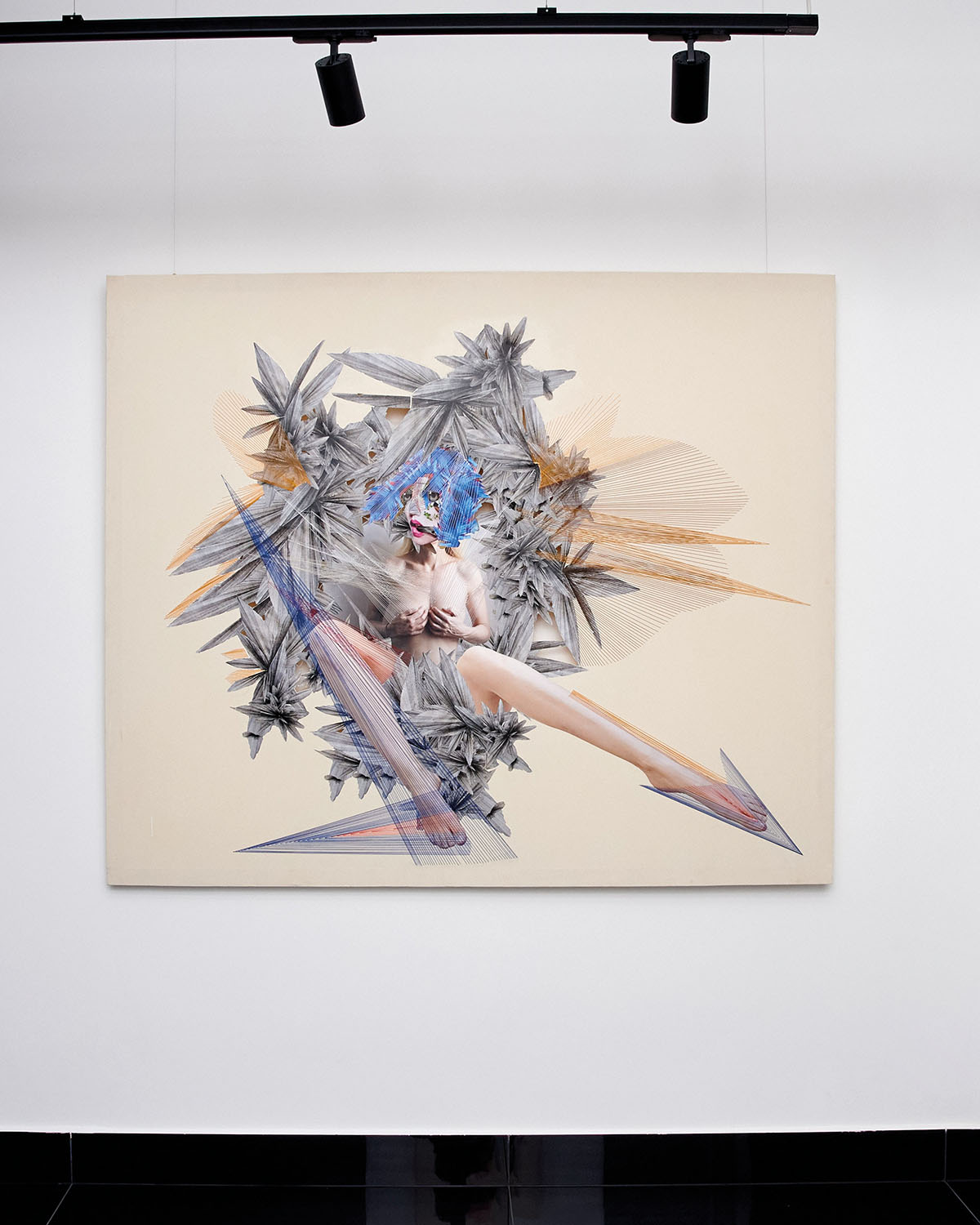
Katrin’s work is also methodically consistent throughout her whole practice. She’s doing something new, introducing cut-outs into her canvases and stitching on two levels: physical stitches and metaphorical ones. The base is always a photograph of herself, which she collages and distorts, creating tension between the face and the body, between what is hidden and what is revealed. It’s a very dynamic work that marks a new step in her artistic development.
Viktoria is showcasing works from her new series „Prime instincts“ for the first time publicly; they show bodies in the midst, melting together; we’re not quite sure if they are embracing or separating. What’s fascinating is that she doesn’t photograph only models; she photographs materials like silicone and other substances, then spends an unbelievable amount of time in post-production blending them until they look completely organic. You can feel the passion and precision in her work; every detail is alive. The transformation feels so real that it almost hits you in the face.
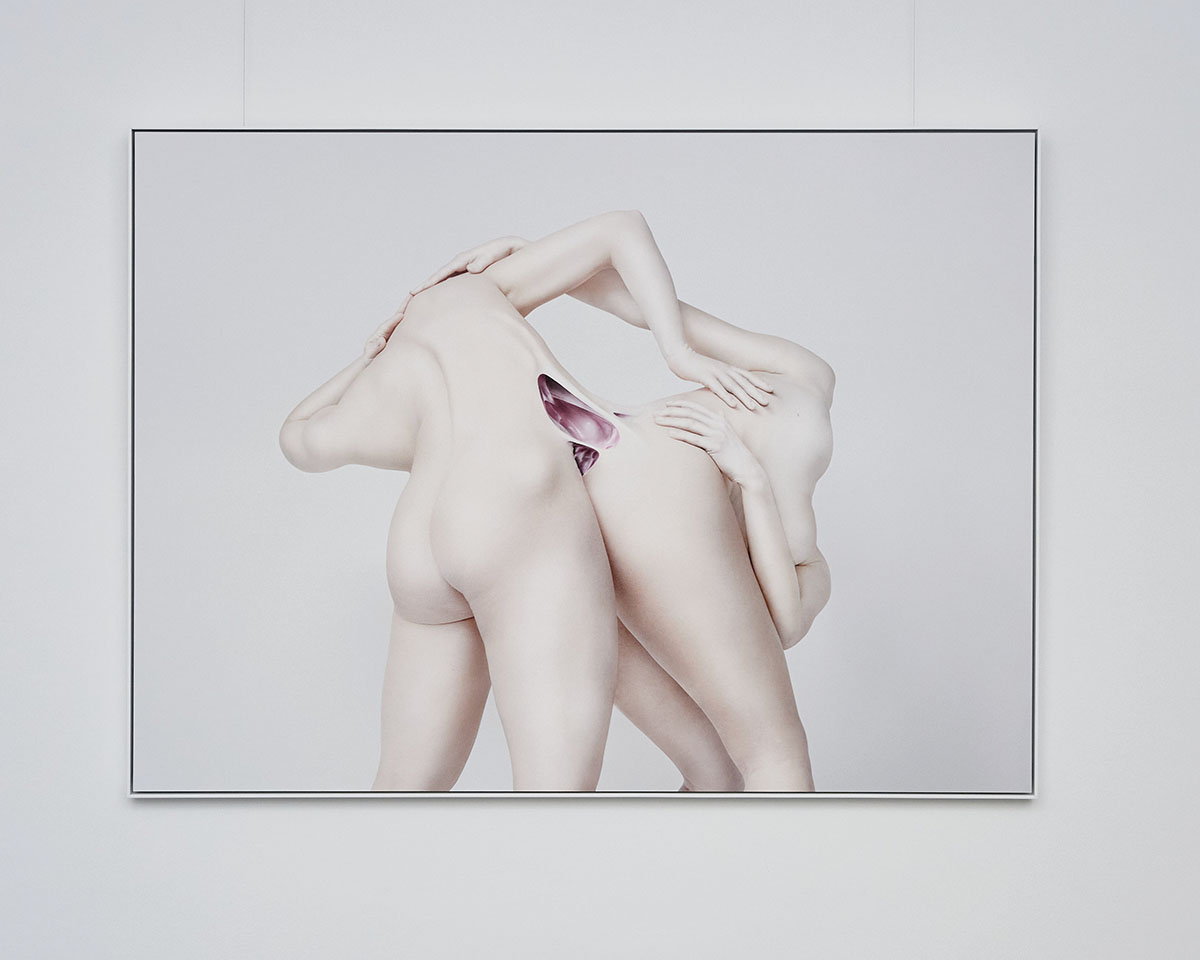
How do you understand your responsibility as a curator toward the artists and their work?
Anne: As a curator, I see myself primarily as a mediator, a translator between the artists and the public. My task is to understand what the artists are doing and what their work is about, and to communicate that clearly. Artists often work intuitively, and my role is to give that intuitive process a language, to articulate it in a way that reaches others. It’s a supporting role, not a leading one, and that’s exactly why I chose this profession.
From a managerial point of view, what was important to you about this first exhibition?
Ruslan: It was essential for us to express the gallery’s approach right from the start, because naturally, there’s a lot of attention on a gallery’s first exhibition. We wanted to show clearly who we are and what kind of program we’re building for the future. Another important factor was the artists‘ personalities. Since our focus is on long-term collaboration and the quality of relationships, it’s not just about the artwork but also about personal chemistry. You need to find out early whether you can work together in the long run.
And how does it feel for you to walk through this new gallery space alone, with its architecture, light, and reflective floor?
Ruslan: I feel deeply satisfied. We wanted to make the space as natural and harmonious as possible. During the renovation, we discovered hidden niches behind the walls; instead of covering them, we decided to leave them open. That decision represents transparency and honesty. The space itself feels elegant and minimalistic, yet distinctive. The reflective floor was actually inspired by the Ural Vision Gallery (mother gallery)—it also had a reflective surface. We decided to keep this feature because it works incredibly well in the gallery context, even if it’s completely impractical! It adds a very specific impression and atmosphere.
Current exhibition: METHAMORPOSIS curated by Anne Avramut
Artist: Viktoria Andreeva, Kata Oelschlägel, and Katrin S. Weidhofer
Opening times: Tue–Fri: 13:00–19:00, Sat: 13:00–16:00
Address and contact:
Salz Vision Gallery
Salzgries 8, 1010 Vienna
www.salzvisiongallery.com
ww.instagram.com/salzvisiongallery/



